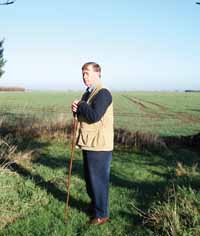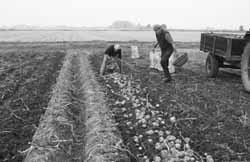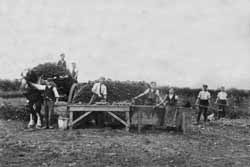Fen farmers with soil in their souls

My family have been farming in the Fens for at least 10 generations, witnessing many changes in prosperity, labour and agronomy.
I started writing my first book in 2000 when I was 60 and have since written two more. Having covered the transformation of this area from fen mere and marsh to fertile flood plain, and some of its non-farming families, I wanted to write about agriculture and horticulture – and so the idea for Soil in Their Souls was born.
I believe the farmers and growers in this area have a different affinity with the soil than most, knowing it was either embanked from the sea (marsh) or reclaimed from flooding from upland waters running into the Fens (fen).
It was our forebears who undertook the daunting task of transforming this area to agriculture and many of those same families continue farming here. They have a unique bond between “soil and soul”, with each generation wishing to leave their soils as a sustainable inheritance to the next.
It was drained to farm – and so it should remain as long as there are mouths to feed. Areas turned back to marsh and mere I can tolerate to a degree, if it does not disrupt our drainage systems.
But most of the Fenland towns and villages were built on high ground on Grade 1 soil and I find it hard to accept that this is the area of the greatest loss of these soils through urbanisation today. In the UK, 50% of the Grade 1 soils are in the Fens. We are selling the family silver.
The rises and falls in agriculture prosperity have affected this area greatly, and yet many people still make their living from the soil. However, the ever-increasing demands on our lands are of concern to those in the Fens. Each generation is replaceable – fen topsoil is not.
The variety of crops which are grown has changed little over the years, but the traditional farms have been largely replaced by large high-tech agro-businesses, supplying supermarkets and international corporations.
I wanted to explore the changes and development of this fascinating region, from land reclamation, smallholdings and horses to aerial spraying and multinational workforces.


TIME FOR OPTIMISM
Land ownership since the 17th century has changed more than elsewhere in the UK, driven by adventurers, speculators, investors, county councils and the fortunes of farming.
The farming industry in the Fens at present is in an optimistic mood compared to some periods in the past, but we live in a global marketplace where speculators rule and change could be just around the corner.
Many of the families here are longstanding and remember the good and bad times as well as flooding – it is ingrained in their sub-conscious.
Not all farms in the Fens are large and the richness of the soil still enables the small grower to survive in a niche marketplace.
Two agricultural enterprises I document in the book to illustrate this are Sunny Templeman and his family, who make a living on 40 acres of Grade 1 silt, and Robin Hancock of Lincolnshire Field Products whose family farms 16,000 acres around Spalding – both growing high-value crops with their own marketplace.
The small growers and farmers have survived through resilience and finding a niche market place for their goods. The larger growers have been driven to expand through economies of scale and pressure from the supermarkets and processors. The outcome has been the loss of the medium-size farm of between 200 and 1000 acres, along with a generation of would-be farmers.
It has always been in my mind how precious our fenland soils are – much more than a tool for growing crops. I believe one should farm with a conscience, and knowing the fertility and structure of soils is our lifeline for the future.
All soils were conceived by nature, but what makes the fen soils different is that man himself delivered and humanised them.
I set out to see if my ideals were shared by others by visiting the large agri-businesses alongside the remaining smallholders and growers. I already knew many of them, having lived among them all my life, while others I got to know. It soon became evident that this love of the soil was widely evident among the farming community.
The farmers and growers on the black fens have witnessed the loss of their soils more than anywhere else. Some have seen as much as a foot of their precious soil disappear during their lifetime. A sad sight indeed. The silt soils at certain times in history have been farmed to extremes and may have to be again to fulfill the demands of our growing population and the loss to urban development. And even the heavier fen soils have witnessed a loss of organic matter from their transformation from grass to arable cropping during the Second World War. This phenomenon has not gone unnoticed, but fen farmers are accustomed to change, and it has and always will be a land of change.
Also by Rex Sly
From Punt to Plough – a History of the Fens, Sutton Publishing. Explains how the mammoth drainage schemes of the 17th century conceived the birth of fenland agriculture
Fenland Families, Sutton Publishing. Profiles some of the family businesses trades and professions in existence for at least three generations
